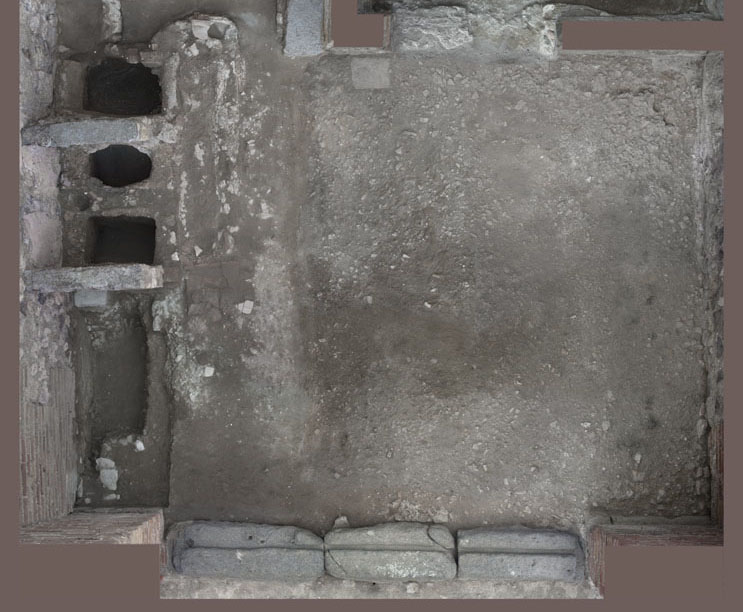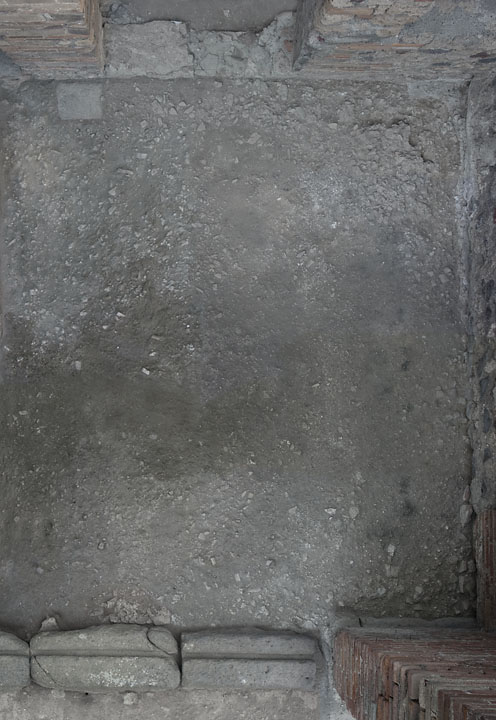Floor
Description
Susanna Blåndman
The east part of the floor was cleaned and documented during the field season 2011 and the west part of the floor during 2010. The floor consisted of five original layers, presented according to their elevation.
Building debris?
Close to the northeast corner of room 3 there is a slightly elevated area (elevated up to 0.09 m), irregular in shape and almost one square metre large, that consists of greyish mortar, fragments of bricks and roof tiles. The north and east sides are more distinct than the others but there is no clear limit to the surrounding area. To the northeast the area partly overlaps patches of two different floor levels; the remains of both the porous lime-concrete floor and the firm lime-concrete floor, at a distance of 0.52 m from the north wall and 0.18 m from the east wall.
Cocciopesto floor
A fragmentary and extremely badly preserved floor made of cocciopesto can be found in some places. Only fragmentary pieces remain, held in place by soil and filling material. Fragments of the floor are found in three places in the southwest part of room 3. There is one patch, measuring 1.30 x 0.18 m, located at a distance of 0.65 m from the doorway to Via di Nola and 0.92 m from the west wall. A smaller patch, measuring 0.60 x 0.14 m, is located at a distance of 1.35 m from the same doorway and 1.28 m from the west wall. At the east rim of the work floor a smaller fragment of a cocciopesto floor is preserved at a distance of 1.56 m from the west wall and 0.24 m from the north end of the work floor. The patch measures 0.35 x 0.10 m.
In the east part of the room there are also two patches. One is located at a distance of 0.56 m from the north wall and 1.00 m from the east wall and it measures 0.60 x 0.28 m. The other one is located at a distance of 1.26 m from the north wall and 1.00 m from the east wall; it measures 1.74 x 0.30 m.
Remains of porous lime-concrete floor
This layer consists of scant remains of a greyish and porous lime-concrete floor. It is extremely fragile and crumbles easily. There is one patch in the northeast corner that stretches 0.50 m along the north wall and 1.68 m along the east wall. Another patch is located 0.50 m from the north wall and 0.16 m from the east wall. Along the east wall, at 1.06 - 1.68 m from the north wall it overlaps a firmer lime-concrete floor.
Firm lime-concrete floor
In several places in the east part of room 3 there are minor traces of a firm lime-concrete floor. The difference between this layer and the previous one is the hardness of the surface. It is clear that they are two different layers. It is difficult to say if this floor is the same as the lime-concrete floor in room 4. The floor in room 4 is darker, but that can be due to the fact that the sun hardly reaches room 4 and the humidity of the floor surface is constant.
Filling material
This layer covers almost the entire surface of room 3. It contains soil mixed with fragments of bricks, roof tiles and stones, for example cruma and Sarno stones.
L: 4.23 m (E); 5.52 m (N); 4.19 m (W) and 5.50 m (S)
Elevations:
Building debris: 32.45 m.a.s.l.
Cocciopesto floor: 32.37 m.a.s.l.
Porous lime-concrete floor: 32.36 m.a.s.l.
Firm lime-concrete floor: 32.35 m.a.s.l.
Filling material: 32.33 m.a.s.l.



